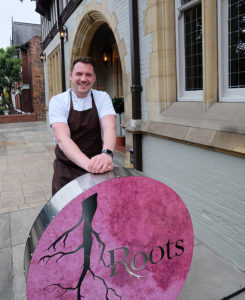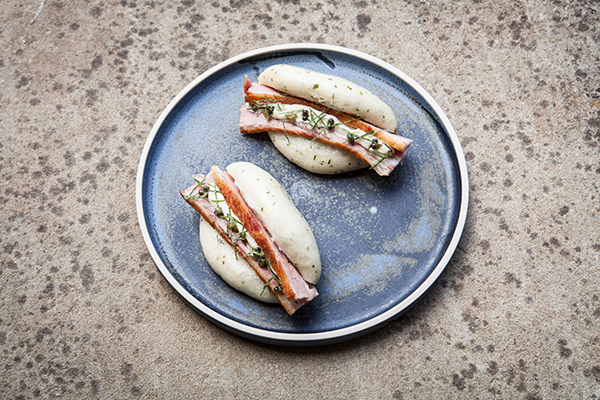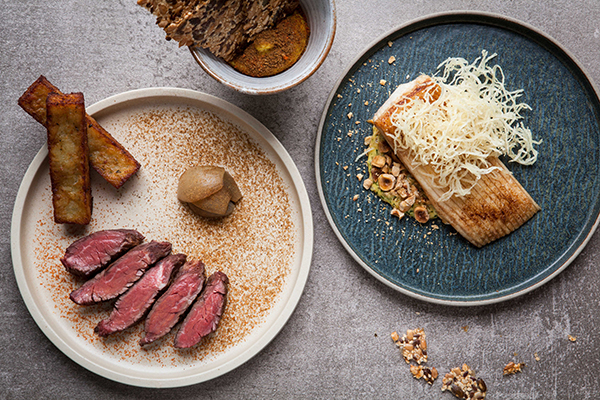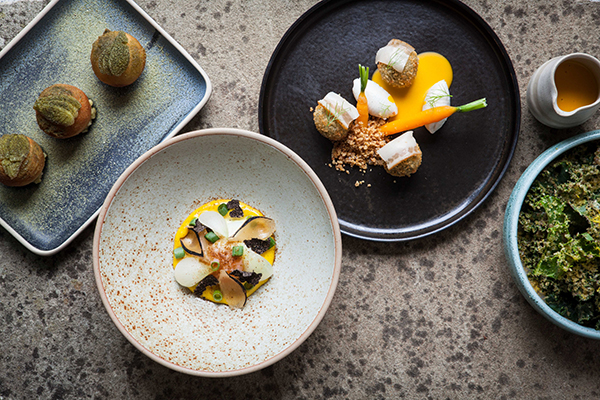The Roots of the matter: Tommy Banks' new restaurant reflects the bounty of the seasons
The bounty of the seasons drives the menu at Roots, the new sharing plate restaurant in York from Michelin-starred chef Tommy Banks. Vincent Wood checks it out
The Guardianâs Grace Dent described her visit as a âone of the loveliest lunches of 2018â and awarded it 9/10 across the board. Roots is more accessible â" both in terms of its sharing plates concept and its location, five minutes from York train station â" than the Black Swan in the village of Oldstead, located in the heart of the North York Moors National Park.
The site is all pale wood and finesse, a mixture of history and personalised touches. Part of that is loyalty to the listed building â" Banks stripped out the disco lighting the former tenants had placed behind the Victorian glass ceiling â" and other elements have been tailormade, like the bespoke tables with root-like metal legs that twist towards the floor, or the handcrafted plates made by Alison Wren, Surrey Ceramics and York-based potter Jane Schaffer, who also supplies the Black Swan.
While the design of Roots is more casual, the style Banks honed at the Oldstead pub runs throughout the menu, continuing the chefâs commitment to quality, to the farm-to-plate concept and to his particular eye for seasonality.
Strictly seasonal

âItâs hard workâ he says, âbut Iâve got all sorts of amazing roots. Iâll have Jerusalem artichokes, theyâll work brilliantly. Weâre drying kilos and kilos of chicory root, which we use in our desserts and in cocktails.â His commitment to the seasons involves months of planning and a largescale shifting of staff between the sites. Everyone front of house and roughly half the kitchen staff have spent a few months at the Oldstead farm ahead of the siteâs launch.
He adds: âThe hunger gap doesnât exclusively feature preserved produce. In January Iâll speak to my mate down in Pudsey, who supplies Yorkshire rhubarb, so Iâll use that in desserts and in savoury dishes. And as you get into February/March time, you can start foraging, so weâll use wild garlic. It isnât exclusively preserved food, but thereâs very few seasonal gems you can actually use.â
But Roots is no quaint nod to the idea of the self-sustained kitchen. âSometimes you walk past a restaurant and they have a line of Kilner jars of things theyâve made and thatâs quite pretty,â he says. âBut here weâre talking about hundreds of kilos of preserved produce. We have a giant shipping container thatâs full.â
The idea of turning his style to a more casual, sharing-based menu came late in the evening after filming Great British Menu. The chef has managed to claim victory twice for his fish dishes on the show and it was eating at a tapas restaurant with other competitors that inspired his new venture. âWeâd sit in Ibérica and chat over a beer and a plate of chorizo â" and I thought, itâs so enjoyable doing that sort of thing. Not that you should really, when youâre in the depths of Great British Menu, be thinking about a new restaurant concept.â
The enjoyment extends to his kitchen. While the Black Swanâs star-earning calibre requires absolute precision, the more rustic approach at Roots means service is a much more quick-fire affair. âThe first few days we had so much fun. At the Black Swan, you might have to dress a dish with 15 tiny leaves, which takes time and precision. You need one person working on one customerâs dish, but here I dress five plates at once. I enjoy it; itâs so nice to dip between two totally different styles of food. I think itâs really important when you open a second restaurant that it is very different from the first one.â
Another change in service is the ticket system â" gone is the rail of tickets, replaced by a screen that uses an algorithm to throw up orders in exactly the way Banks wants. âItâs 2018, why would I want to write things down on pieces of paper and move them around when I can I have it all on one system?â
However, there is some carryover from the Black Swan. Banksâ Crapaudine beetroot, slow-roasted in beef fat and topped with pickled discs of golden and red beetroot, alongside horseradish goatsâ curd, smoked codsâ roe emulsion and linseed crackers, is on the menu of both restaurants.
âThatâs a big dish for us because we have five acres of beetroot at the farm,â he says âMy idea is to grow enough beetroot that we could serve that dish to everybody that orders it â" because itâs our signature, and everyone has it at the Black Swan because of the tasting menu. Enough beetroot for a whole year is quite challenging.â
While not a crossover, as it is no longer available at the Black Swan, on the menu is a 2018 version of Banksâ Douglas fir parfait with lemon verbena gel. It is not, however, the dish he encourages you to eat.
âIâve got this carrot dessert â" itâs phenomenal, but nobody orders it! People order the Douglas fir because it was on Great British Menu and they order my grandmaâs apple cake because itâs my grandmaâs apple cake â" but thereâs this carrot dessert that nobody orders, and itâs brilliant.â
The dish is essentially a tiramisù, incorporating caramel made from the juice of carrots grown from the farm, combined with rye shortbread and burnt chicory root.
âPeople are using us as a destination eating establishment and maybe thatâs what weâll end up being because youâre led by your customers. I thought weâd have a lot more people come â" especially at lunchtime â" sit down, order a couple of plates, be in an hour and leave. They arenât really using us like that, people are booking tables and theyâre having a really good do. Theyâre having 10 plates between them and lots to drink, and they seem to be loving it.â
Roots is certainly more relaxed than the Black Swan â" but is it unrealistic to consider a future Michelin nod for the restaurant? Banks says it doesnât really cross his mind.
âI think itâs about being busy, cooking the food that weâre happy with and hopefully the customers are happy with, and thatâs it really. If Michelin come, and I think they will, maybe it could be a Bib Gourmand. If they want to give it a star, then fine, but we didnât set it out to be starred. If I was really setting out to try and open a Michelin-starred restaurant, I would have probably done another tasting menu restaurant, or à la carte, rather than sharing food. Sharing food is⦠Itâs not that it canât win a star â" but itâs more casual, isnât it?â
Banksâ work blurs the line between the two â" as can be seen by the range of customers who walk through his door, from men in their 20s with their mothers, to people in their 50s talking about the beetroot dish as if they have eaten it five times before and elderly women giving the chef advice on his choice of decor.
âI think that carries on from the Black Swan a bit. We get such a varied demographic of people who come to both restaurants. We get real foodies, then because Iâm fairly young we have quite a young crowd as well. I think itâs because Iâve done TV that Iâve got a very varied crowd, but what I love about both here and the Black Swan is you may get a young couple of lads in T-shirts just having a nice time. Then there will be people dressed up in their absolute Sunday best and neither really stands out. I think itâs fine. Itâs about the food really, more than anything.â
Roots York, 68 Marygate, York YO30 7BH
www.rootsyork.com
Opened 14 September
Covers 60
Founders Tommy Banks, his parents Anne and Tom Banks, his brother James, and restaurateur Matt Lockwood
Head chef Tommy Banks
Development chef Nick Brown
Restaurant manager Emma Byrne
Tommy Banksâs career to date
Tommy Banks began working at the Black Swan at Oldstead, North Yorkshire, after his parents, both farmers, bought the site in 2009.
Starting as a traditional village pub, the Black Swan went on to gain a Michelin star in 2012 under chef Adam Jackson. Banks was catapulted into the spotlight when, having taken over the kitchen at 23 years of age, he retained it to become the UKâs youngest chef to hold the accolade at the age of 24.
The Black Swan, which retained the star in the recently published 2019 edition of the guide, relies heavily on produce on its three acres of farmland, which is cultivated by staff from both front and back of house.
The Black Swan, which is still a family affair, was named Tripadvisorâs Best Restaurant in the World last year. The chef has also received plaudits outside of the family business â" winning BBC TVâs Great British Menu twice, in 2016 and 2017.
From the menu
⢠Roots sour bread and seed crackers, Lincolnshire poacher custard, cultured butter £5
â¢Â Kale dressed in sheepâs yogurt, pickled walnuts and cured egg yolk £5
â¢Â Sour pea falafel, pork fat and carrots £8.50
â¢Â Cured trout and Oldstead piccalilli £8.50
â¢Â Crapaudine beetroot cooked slowly in beef fat £10
â¢Â Oldstead onions, duck egg and truffle £14.50
â¢Â Thornback ray wing, âtartarâ sauce and hazelnuts £16.50
â¢Â Ox cheek, cauliflower and kale £17.50
â¢Â Skirt steak âsour garniâ £17.50
â¢Â Cod, broccoli, smoked mussel sauce £20
â¢Â Courtyard Dairy cheese £14
â¢Â Mary Banksâ apple cake, Oldstead honey and crème fraîche £8.50
â¢Â White chocolate, Douglas fir and lemon verbena â2018â £8.50
â¢Â Carrot and chicory root tiramisù £8.50
â¢Â âFruit and Kernelâ, damsons with woodruff toast £8.50
Or a selection of sharing plates â" the âRoots Feastâ â" priced at £50 per person




















